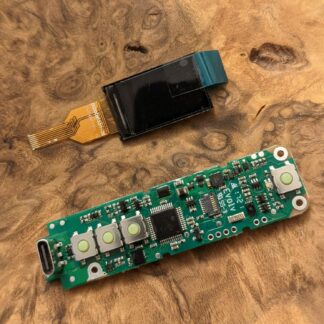Here is Evolv’s official tutorial:
Here are our collected thoughts and advice. This list may update and be added to in an ongoing manner.
- When starting out with temperature protection, start out with simple single coil builds. Larger diameters are recommended, 3-4mm mandrels work well. 30 gauge wire is recommended as a starting point, as it is a good mix of ease of handling and enough resistance to fall within a good range for the board. Try 8-12 wraps.
- Ni200 wire is significantly softer (more ductile) than Kanthal and Nichrome, and this can make handling challenging. On one hand it’s easy to form coils, but on the other hand its easy to deform them while placing them in the atomizer. Small, lightweight mandrels help, as does compressible wicking such as cotton.
- Ni200 wire is easily cut off by overtightening post screws. It will take some trial and error but you need to find a happy medium between tightening the wire and cutting it off. It may work to double up the wire at the post hole, or to insert an additional small piece of wire at the post hole.
- When wicking with cotton, compress or roll the cotton tighter than you would do with Kanthal/Nichrome. You do not want to have to use much force to thread or pull the cotton through the coil.
- When using silica or other similar wicking, try wrapping the nickel wire directly on the wick. It may be possible to use the wick itself as the mandrel, depending on the gauge of the wire and the specific build. This is especially useful for rebuilding commercial heads such as Kanger or Aspire.
- If you are building well, nickel builds should last significantly longer than non-temp builds. Dry hits should be eliminated entirely.
- If you are having trouble with temperature regulation mode turning on and off unexpectedly, or with resistance readings fluctuating, the most common issue is bad coil connections. Check to make sure the post screws are tight enough and that the 510 connection is clean and dry.
- If you are having vapor production problems and/or early temperature cut-off, you may have a hot leg, hot coil, or bad wick contact. It is possible for wicking to shift while in use and temperature control responds much more noticeably to that condition than non-temperature.
- PG has a lower boiling point than VG, so the PG/VG ratio can affect the optimum temperature.
- The DNA 40D does “refinement” of the ohm reading when the mod is idle. This means it monitors the coil resistance and updates the ohm reading if it can be made more accurate. It is common for refinement to lower ohms by 0.01-0.02 below the initial reading after the mod has been sitting for several minutes, it should not cause an increase in resistance or a fluctuation; that is likely a coil connection issue.
- The ohm reading displayed in temperature mode is not necessarily the ohm reading of the coil. It is a reading that is normalized to a fixed temperature.
- Setting the wattage on the mod comes down to personal experience and preference. Some find that setting to high or max wattage and letting the board automatically down-regulate works fine in most to all cases. Others find it preferable to set wattage closer to the max operating wattage of the specific build. Try both.
Additional info 1:
- True micro coils are usually best avoided with Ni200, that is contact coils of a very small diameter. Contact coils can be tricky to get working on Ni200 in general. Spaced coils are recommended.
- Do not be afraid to increase the temperature to meet your desired vape. Although dry cotton can scorch at ~420F, once the cotton gets wet with eliquid, it can go a lot higher without burning. Even when the atty is vaped “dry” cotton wicking never really gets truly dry again.
- Now that premade coils are available, we recommend getting some when starting out with nickel. This helps alleviate any frustration that may occur during the learning curve, plus they give a reference point for a “known good” coil that can help differentiate between build and device issues.
- Screwing and unscrewing the atomizer repeatedly in an effort to get the “new coil” message or to get the mod to change its reading is improper operation. Do not do this, it cannot accomplish anything helpful. It is normal to not always get the new coil message, and tricking the mod into misreading the coil will cause problems.
Additional info 2:
- Regarding the new “atty lock” function: Be aware that atty lock can introduce error into the displayed temperature. Refinement is automatic calibration of the temperature readout. We do not recommend using atty lock to pre-empt refinement, but if anything to lock in a refined reference ohm reading.
Links
Official Evolv DNA-40D datasheet
DNA temperature protection user group on Facebook



